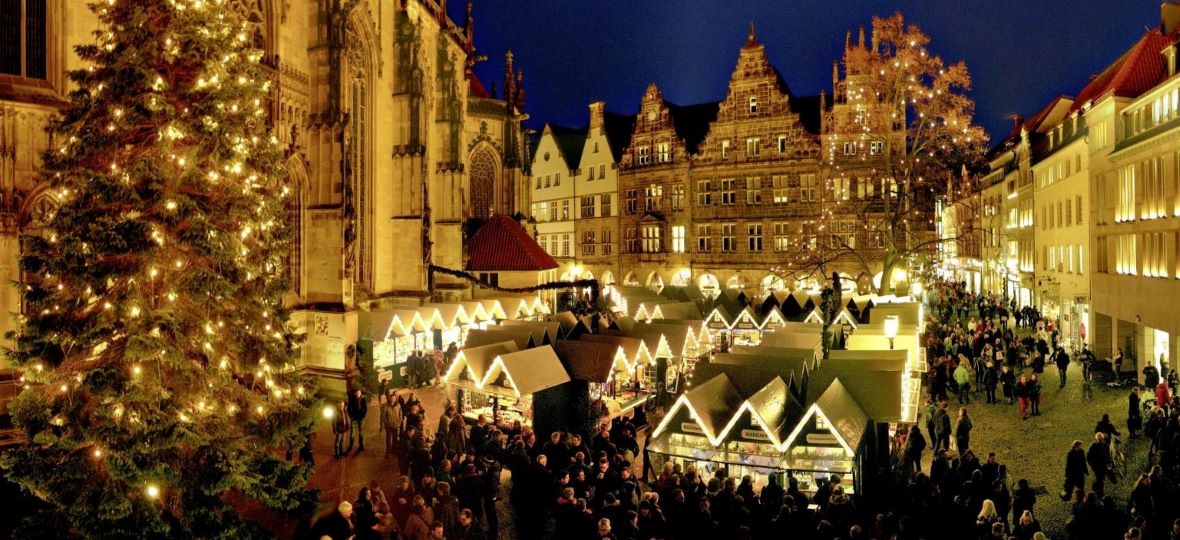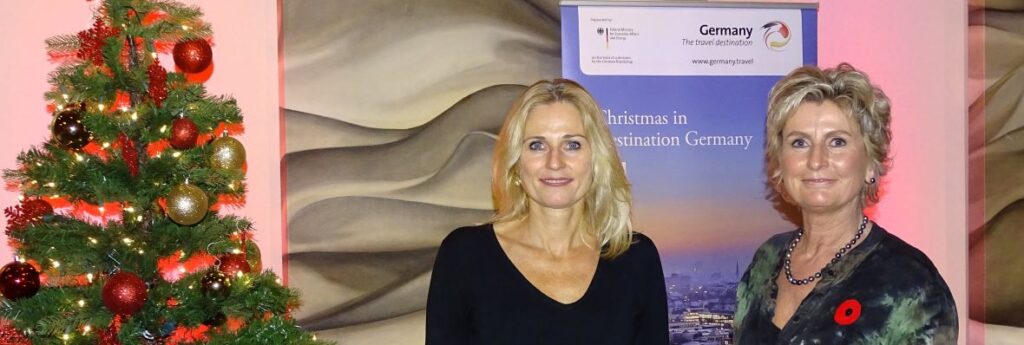Getting together again was like Christmas, literally, for the German National Tourist Office as it celebrated its first in-person trade event since the start of the pandemic at a gathering in Toronto late last week. Themed around the upcoming festive season in Germany, the tourist board also publicly unwrapped its new Canadian director, Anja Brokjans, now about six months into her tenure.
GNTO Americas director Ricarda Linder flew in from New York for the occasion, telling Travel Industry Today that she was thrilled to be able to do so again and remarked how seamless the travel experience was at Pearson – a good sign for a return to travel.
Linder shared with guests the news that fully vaccinated Canadians are welcome again (without COVID testing requirements) in Germany, which is expecting to see a strong tourism rebound in 2022, not least with the delayed Oberammergau Passion Play at last taking centre stage for its once-a-decade performances.
In the spirit of the moment, and in the glow of the first Christmas tree of the season, Brokjans introduced the evening’s theme, declaring, “The good news is: Christmas markets are back on again!” and noting that almost every town in Germany has one.
Many of the Weihnachtsmarkt/Christkindlesmarkts start as early as next week and continue until just before Christmas (in some cases a few days after).
Typical German traditions for the festive season, winter activities in the great outdoors, and selected Christmas markets are all showcased in the latest promotional campaign from the GNTO, with the hopes of providing inspiration for visits to Germany in the run-up to Christmas.
The 2021 Christmas campaign is designed to “whet the appetite for travel to Germany” by highlighting typical customs and traditions in various regions and offering fresh ideas for city breaks and cultural tourism.
In a distinct sign of the times, the tourist board also makes a point of declaring, “All the markets and travel ideas promoted in the campaign are subject to rules specifically adapted to the latest coronavirus situation, ensuring that this season will be enjoyable, safe and relaxed.”
At the heart of the ‘Christmas sparkle’ campaign is a landing page (click HERE – https://www.bit.ly/3n75uee) with links to the regularly updated websites of the biggest Christmas markets, plus activities and events during the festive season, and winter offers. The campaign began Nov. 8 via social media, programmatic advertising, search engines and newsletters, and includes activation in the Canadian market.
“Last year, Germany was able to retain its position as the leading destination for cultural and city travel for Europeans, despite the COVID-19 pandemic. The unique atmosphere associated with the festive season in Germany’s towns, cities, and regions was a particular draw,” says German National Tourist Board CEO Petra Hedorfer. “We are delighted that the current coronavirus situation means we can open Christmas markets and welcome international visitors again at this special time of year. Our campaign offers specific tips to whet the appetite for cultural travel to Germany.”

Here, courtesy of the GNTO, are just some of the Christmas-time traditions in Germany that visitors can discover:
Baden-Württemberg
A leisurely tour of the extravagantly decorated royal chambers at Burg Hohenzollern, a fairytale castle located on the edge of the Swabian Alb, is a real treat at this time of year. And Schwetzingen Palace is also awash with Yuletide charm. During the festive season, light artists transform this former royal residence into a Christmas wonderland with illuminated gardens.
Bavaria
Every winter, the landlady at Hündeleskopfhütte in the Allgäu Alps prepares the two-kilometre toboggan run from her mountain restaurant. Armed with head torches, her more adventurous guests can then ride their sleds back down, but there are also torch-lit walks for those who would rather venture out on foot at night.
Berlin
Must-sees include the sparkling Christmas tree at the Brandenburg Gate, the tree-lined avenue Unter den Linden decorated with fairy lights, and the shining stars in Lichtenberg. The Christmas Garden Berlin in the Botanic Gardens is another fairytale setting with light installations and a tree with wish lists hanging from its illuminated branches.
Brandenburg
During the festive season, Potsdam, a former royal seat of power, offers a special ‘Potsdam Christmas stories’ tour. Starting at the old market square, the tour explores the historical city centre and continues to the Dutch quarter, while the guide recounts anecdotes about Baby Jesus and Father Christmas. The historical trams serving glühwein are a popular means of travel between the Christmas markets. The absolute highlight is a stroll around the ‘Blauer Lichterglanz’ Christmas village.
Bremen
At Christmas time, Germany’s bakeries are a hive of activity. The Hanseatic city of Bremen, in particular, is known for its irresistible klaben fruit loaf. This Christmas cake, which was first mentioned by Bremen’s council in 1593, is made with yeast dough, sultanas and almonds, and flavoured with cardamom. Anyone can bake this delicious cake, but only klaben made in Bremen is allowed to use ‘original,’ or genuine, in the name.
Hamburg
In Hamburg, even Christmas has a maritime edge to it. During the traditional ‘Tannenbaumwerfen,’ or conifer throwing, a barge full of trees cruises around Hamburg’s port. The trees are then thrown onto the bigger ships so that the sailors on board can enjoy Christmas even when they are far from home.
Hessen
Berlepsch Castle, perched on the hills of the Werra valley, is part of the German Fairytale Route and the perfect setting for an atmospheric Christmas market. The centuries-old fortress is a riot of traditional decorations and offers medieval music, mulled wine, street entertainers and handmade treats. The fairytale readings are a real hit with the kids, as are the fairytale days throughout the year.
Mecklenburg-Western Pomerania
On those days when snowflakes dot the air and the low sun bathes everything in a soft light, a winter walk along one of the ten thalassotherapy trails in the seaside resort of Warnemünde, the Stoltera nature conservation area or Rostock Heath will lift your spirits. Visitors with an interest in culture should head for the Ahrenshoop art trail, a circular walk that features works by renowned artists from the Ahrenshoop artists’ colony founded in 1892.
Lower Saxony
In the run-up to Christmas, many homes in Lower Saxony are filled with the smell of baking. In Bentheim, flat cakes called schoosollen (shoe soles) are baked over an open fire, while Lüneburg Heath is known for its heidesand biscuits. On the North Sea coast, thin treats known as rullerkes or neejahskoken are made in a waffle iron and often enjoyed around New Year with a cup of East Frisian tea.
North Rhine-Westphalia
Germany’s most unusual, and possibly most beautiful, ice rink can be found at Zollverein mine, a UNESCO World Heritage site in Essen. Every year in December, what was once the world’s largest coal mine is transformed into a 150-m.-long ice rink along the large coking ovens and chimneys. The rink is a sparkling delight at night, while the winter village next door ensures you won’t go hungry.
Rhineland-Palatinate
A winter walk near Wasserliesch, an area renowned for its wildflowers, is particularly romantic at Christmas time. Follow the Moselsteig trail to Löschem Chapel, which stands high up on the edge of a slope and offers stunning views of the Moselle valley and the Eifel and Hunsrück mountains. Torch-lit walks around Andernach and Neuwied on the river Rhine are another popular winter activity.
Saxony
It’s always Christmas in Seiffen in the Erzgebirge mountains. The town is famous for the handcrafted Christmas pyramids, nutcrackers, angels, candle arches and incense smokers that have been made here for generations and are sold throughout the year. In the run-up to Christmas, the spa resort dons its finest festive threads and invites visitors to the Seiffen Christmas market and the Nativity play in Seiffen church, which is often depicted in regional artwork.
Saxony-Anhalt
As Christmas approaches, Magdeburg switches on 1.2 million little lights. The city is transformed into a glittering wonderland of decorated streetlights, large baubles you can walk around in, twinkling holy figures and a festively illuminated cathedral square. Elsewhere, a ride on the Harz narrow-gauge railway offers a touch of nostalgia. The historical steam engines set off from Wernigerode through a snowy winter landscape to climb Mount Brocken.
Schleswig-Holstein
Lübeck is northern Germany’s Christmas city. Home to the famous Holsten Gate and magnificent churches, this Hanseatic city is especially beautiful during the festive season. In addition to Christmas markets, there is a fairytale forest at the foot of the Church of St Mary, a Yuletide wonderland at the European Hansemuseum featuring elf huts and a kissing arch, and the ‘Lübsche Wiehnacht’ craft market. And no Christmas is complete without Lübeck’s most famous product, marzipan.
Thuringia
Lauscha, a small town in the Thuringian Forest, is the birthplace of the baubles that feature on Christmas trees around the world. Legend has it that the local glassblowers could not afford nuts and apples to decorate their Christmas trees with, so they made decorations out of glass instead. The traditional glassworks in Lauscha are open to visitors all year round, and the decorations can be bought from the workshop studios. Anyone with a particular interest in this traditional craft is encouraged to explore the 15-km Lauscha glassblowers’ trail. A romantic ride on the illuminated mountain railway through the forests of the Schwarza valley is also highly recommended.

